Puerh Tea
Brewing Puerh Tea with the Clever Coffee Dripper January 05 2014
Learn to brew puerh tea with the Clever Coffee Dripper.Crimson Lotus Tea goes to the Vancouver Tea Festival November 05 2013
This last weekend my wife Lamu and I went to Canada for the first Vancouver Tea Festival . We’re still quite new to the tea world and have been taking every opportunity to steep ourselves. We first volunteered at the Northwest Tea Festival this October. It was a rewarding experience. We got the opportunity to meet with a lot of other tea vendors and experts. We decided to make every effort to attend the Vancouver Tea Festival as well. I’ve chatted with the director, Del Tamborini, on facebook a few times and he highly encouraged us to make the trip.
Vancouver is very close to Seattle. You can drive there in under 3 hours. There is just one major hurdle and that is the border crossing. It is a wild and unpredictable element in an otherwise short trip. The border is made even more exciting given Lamu’s changing immigration status. We’ve been going through the process of obtaining her green card. Our trip to Vancouver hinged on her being accepted and receiving her green card in time. This last Saturday was the tea festival and on Friday we were eagerly awaiting the postman’s arrival. Sadly, he did not bring us her green card. What he did bring was paperwork announcing the imminent arrival of her green card. What a tease! We decided to pack our bags and head up to the border and see what would happen with this paperwork.
The Canadian border guards were not as convinced as we were on the legitimacy of this paperwork and after a small wait they sent us back to the American side. They explained that they didn’t want Lamu to get stuck in Canada. I completely agreed with their concern. Quick U-Turn back to the American side and we were greeted with the friendliest border guard I have ever met. This American border guard assured us that the paperwork we had was more than sufficient for re-entry into America and that we were more than welcome to head up to Vancouver for the festival. We could rest easy knowing that both of us would be assured quick and easy passage back home. We got back in the line for the Canadian side and they let us through. We were more than simply excited. Lamu has been wanting to visit Canada for a long time. Being able to visit with the excuse of attending a tea festival was an added bonus.
We woke up super early and got to the tea festival in plenty of time. It was a good thing that we did. The festival was packed! Packed beyond packed would be a good description. Being one of the first in line let us meander while the crowds were still attempting to get in the door. I was immediately drawn to The Chinese Tea Shop’s booth. [ http://www.thechineseteashop.com/ ] This is my kind of tea! Brewed gongfu style with quality leaves. I met Daniel Liu and his wife and sampled some of their puerh. I had heard about this tea shop before we got to the festival and it was on our list of places to check out in Vancouver. We made plans to visit their store Sunday afternoon.
As the crowds thickened I admired Daniel practicing his tea master craft surrounded by so large a crowd. I began to recognize the difficulty that puerh tea has in a festival environment. Puerh and gongfucha is a ritual that cannot be encapsulated in a 30 second tasting window. When I have guests over for tea tastings it often extends into multiple hours. Puerh itself is not something that can be summed up in a brief description or a half ounce tasting. Puerh needs to be explored to see the true beauty these leaves have to offer.
The other hurdle that puerh has in a festival setting is the overabundance of highly blended teas. For the tea drinker who has never tasted puerh before, and who very well may be looking for what puerh has to offer, it will be hard to notice puerh amongst the intensity of flavor available from blended teas. Everything seems like a pumpkin chai vanilla green tea elderflower jasmine explosion! It’s like listening to music only from a subwoofer. Bass is great, but you need a balance. I don’t really have anything against blended teas, I just feel that they can’t compare to individual leaves of real quality. That is the experience that I am searching for and want to introduce to those who haven’t experienced it before.
On Sunday afternoon we went to Daniel Liu’s shop in Vancouver’s Chinatown and had a chance to discuss the event. He also recognized the difficulty of truly showcasing puerh in a festival environment. It’s an interesting problem that I’ll have to think about before we start attending tea festivals as vendors. We spent a good deal of time chatting with Daniel in his shop. I had a lot of questions about puerh storage for aging and he very patiently answered each of them. His shop really is a fantastic place and should be visited if you’re in Vancouver. He has an amazing collection of puerh and Yixing teapots.
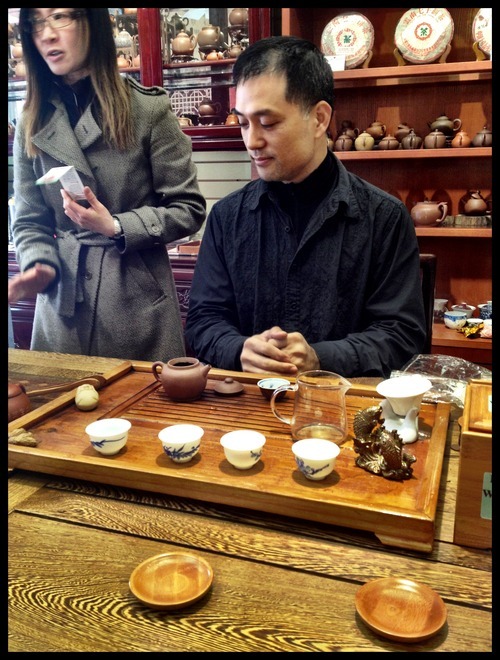
Daniel Liu of The Chinese Tea Shop, Vancouver BC; © Crimson Lotus Tea 2013
Daniel let us sample a few of his teas. We started with a Shou Puerh from Menghai Factory that was about 10 years old. It was a good puerh, but it was made magical by the teapot he chose to brew it in. This amazing little pot was over 200 years old. What an amazing experience tasting tea brewed in something with such a long life. It truly felt like drinking history. My active imagination envisioned the countless teas brewed in that little pot and the conversations shared amongst friends over the centuries.
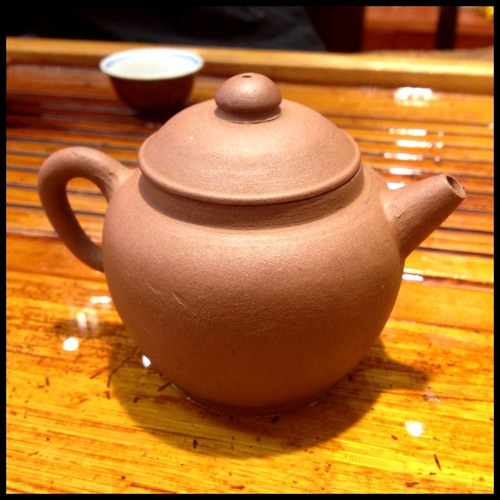
This teapot was brewing tea when George Washington was still alive! © Crimson Lotus Tea 2013
We then shared a Phoenix Oolong in another teapot with a similar lengthy heritage. It was floral and pleasant. Lamu loved it. For me it reminded me that I really like Shou Puerh. The third tea we tasted was a Sheng Puerh from the mid 90’s naturally stored in Guangdong. It brewed darker than I would have thought for being still relatively young. It had a bitterness, but it was perfectly balanced with a sweetness and pleasant aftertaste. What I remembered the most was the ChaQi. It hit me fast and moved quickly up my face, over my forehead, and to the top of my big bald head. I’m not sure I’ve quite experienced it like that before. It was interesting.
Before Lamu and I left she fell in love with a fat little piglet tea pet. We didn’t have a tea pet yet and were waiting for the right one. This cute little guy wanted to come home with us, so we obliged him. Tea pets, if you don’t know, are often made with the same clay as the Yixing tea pots. They are porous and will absorb the tea oils in the same way. Each time I make Shou Puerh I will pour a little bit on his little fat belly. We decided to call him “xiǎo yóu dù” [小油肚]. That means “Little Fat Belly” in Chinese.
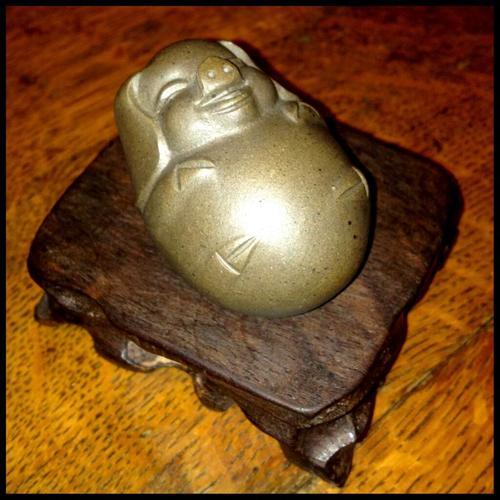
What a contented little piggy awaiting his puerh bath © Crimson Lotus Tea 2013
While in Vancouver, Lamu and I, took every opportunity to sample the local Chinese cuisine as well. We had some delicious dimsum at Kirin in downtown Vancouver. [http://www.kirinrestaurants.com/] I know that puerh tea is often served with dimsum in Hong Kong restaurants, but I have not experienced it first hand. The dimsum restaurants in Seattle do not offer it as an option. I have been curious how puerh is prepared in a restaurant setting. I asked the waiter if we could have puerh tea with our meal and he said of course. Then walking to the kitchen he yelled “POLAAAAAY!!”. I was confused for a minute until I remembered that puerh tea is called “Po Li” in Hong Kong.
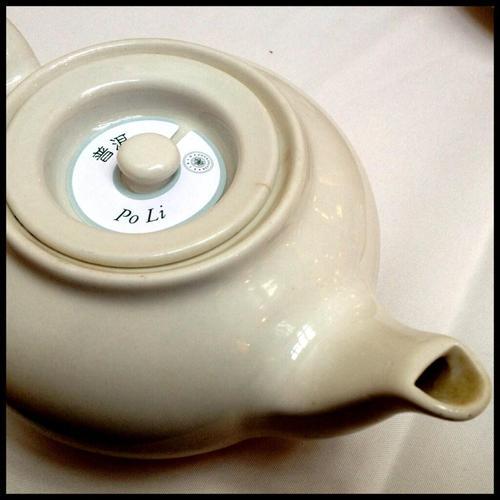
Simple and efficient Hong Kong restaurant style puerh © Crimson Lotus Tea 2013
The Po Li/Puerh tea arrived quickly in a simple white porcelain British style teapot. There were very few leaves inside. The waiter said they only use about a single tablespoon of loose leaf puerh per pot. He had no clue about the age of the puerh, or which factory it might have come from. It was definitely a Shou Puerh. I tried some and it was a very light brew. It tasted like puerh brewed gongfu style after a lot of steepings. However each subsequent cup I poured was darker and darker until the end of the pot that revealed the rich deep earthy puerh flavor I love so much. I was pretty surprised at that. It was like doing it the gongfu way in reverse. I found the experience quite enjoyable. I will certainly be experimenting with that method of brewing puerh at home. It’s really amazing to me how much flavor you can get out of so few puerh leaves. Puerh can be so generous.
After Lamu and I had explored as much of Chinatown as we had the energy for and had collected a large box of assorted humbow to eat while waiting in the border lines we began the southerly journey back to the good ol’ United States. We were happy with the weekend and the tea experiences we were offered and feeling good about the trip. Then we got to the border and our Uncle Sam Approved Certified Assured No Problems Re-Entry documents were denied. As it turns out the Canadian side was right, and the border guard on the US side gave us some really bad advice. The paperwork we had was certainly NOT sufficient for re-entry into the US. After some discussion the guard said with a smirk “Well, we’re not going to deport your wife today!” Then he sent us inside to await their decision.
After some waiting, and talking, and explaining, and re-explaining, and cajoling, and fingerprinting, and background checking, and humbow eating we were allowed re-entry into the United States. It was a good thing we had some good Chinese food to eat while we were waiting. I have now spent a decent amount of time in immigration offices on both sides of the border, and I have to say that the Canadian side is much nicer; especially the restrooms. Why is that? Anyway, bullet dodged, Lamu was allowed to return home with me. As we approached home we were talking about the adventure and the poor advice given to us by the misinformed government agent and we realized that had he been properly informed we wouldn’t have gone to Canada and would have missed out on a fantastic weekend of tea. So Mr Misinformed Border Guard, we thank you!
Puerh Storage, Aging, and Data Munging September 17 2013
“Youth is the gift of nature, but age is a work of art.”
– Stanislaw Jerzy Lec
One of the fundamental aspects of Puerh tea is that it will change with time. It’s what distinguishes puerh from all other teas. In my previous blog post [ http://crimsonlotustea.com/blogs/puerh/10505477-what-is-puerh-exactly ] I explained the bacteriological process that allows puerh to live and breathe and age. Early on in my puerh journey I was focused merely on enjoying puerh daily. As my journey has progressed, my interest in collecting, storing, and aging puerh has increased. My confusion has also increased. I have read voraciously on the topic of storing and aging puerh and have found it hard to find anything but contradicting information. It seems that for the topic of storing and aging puerh only time itself is the true teacher. The left brained part of me is all for some scientific exploration, but standing on the wrong side of a 20-30 year experiment is quite intimidating.
The simplest advice is intended for those puerh purchases that are meant to be enjoyed in the near future. Store the puerh in a dark, cool, odor free, dry place that is safe from dramatic temperature fluctuations. This makes sense and is perfectly reasonable for the short term. Storage for the long term, with the intent to age, is a different matter entirely. This means storing puerh that you feel will benefit from the wisdom of time. You are responsible for the puerh. You have to take care of it. It’s a low maintenance relationship, but it still needs to be taken seriously. From the readings I have done on this topic a consensus holds that the storing and aging done on puerh for the last 30 years in the tropical climates of Southeast Asia, Hong Kong and Singapore specifically, has produced the most flavorful environment for puerh. Outside of Asia there has been little to no long term puerh storage that has been documented and communicated. There is even discussion over whether puerh should be stored in a constant temperature and humidity or allowed to fluctuate with the seasons. When successful tea merchants from SE Asia are asked the secrets to storing and aging puerh the answer is sometimes simply “I put it on the shelf”. I am in search of a little more direction.
I should point out that there is a slight difference in aging when it comes to the two different types of puerh; Sheng and Shou. Both will benefit from proper storage, but it is only Sheng (Raw / Green / uncooked) puerh that truly benefits from aging. Shou (Ripe / black / cooked) puerh is force matured early in its life during the production process. It is a process created to mimic old and aged Sheng. Because Shou does most of its maturation before leaving the factory it benefits little from aging. Shou puerh is intended to be consumed within 10 years. The real magic of aged puerh comes from Sheng puerh. It starts off typically bitter and astringent, but with age can mellow into something truly remarkable.
I’ve built a small puerh humidor (simply named ‘pumidor’ by the internet). Two of them actually. Currently this consists of two large plastic sealable tubs that I took the pain to ensure were odor free. I separated my puerh between Sheng and Shou and sealed them into each tub. Inside each tub are cigar humidifier packets that keep the tubs at 72% RH (Relative Humidity). I also added digital hygrometers to each so I can keep an eye on temperature and relative humidity. The tubs sit unceremoniously, and unobtrusively, in the corner covered with a dark sheet, and are primarily used as a table to hold junk mail. I’ll open them when I am going to get some puerh to drink. Otherwise they are happy to sit there aging. This is sufficient for a small collection, but it has got me thinking of larger scale collections. It wouldn’t be hard to build a climate controlled room where puerh could be stored long term with controlled temperature and humidity. It might get expensive to maintain over a multiple decade time period though. It would be best if Mother Nature could help with the heavy lifting.
The Seattle area can be quite humid. It rains often, and there are large bodies of water in close proximity. I wasn’t really certain how humid though. I needed specific data. I specifically needed data for my exact neighborhood. It is easy to find weather data online, but most sites only detail current information. Some sites hold historical data, but most likely only for the airport closest to you. This wasn’t going to work. What I wanted was a multi year dump of raw temperature and humidity data for as close to my house as possible. While browsing http://wunderground.com/ I noticed that they allow locals to set up their own weather stations and upload the data to their site for processing and storage. As it turns out my neighborhood’s Parks Department has installed a few in the area and has been uploading data to wunderground.com since 2006!
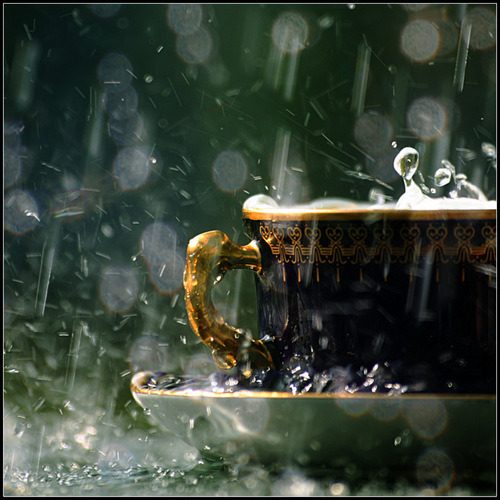
Care for a spot of rain with your tea? © Neal Fowler / Flickr
I found one weather station very close to my house and began the process of harvesting the daily data into a local file that I could use for some good ol’ fashioned data munging. Data Munging, is defined by wikipedia as “the process of manually converting or mapping data from one ‘raw’ form into another format that allows for more convenient consumption of the data with the help of semi-automated tools. This may include further munging, data visualization, data aggregation, training a statistical model, as well as many other potential uses.”. I’m a software geek by trade so this kind of challenge is one that I love. The data files I was collecting quickly grew in size. One years worth of weather data gathered every 5 minutes was easily 10MB. Google Sheets died with little fanfare at each attempt to import that data for analyzing. More munging was needed.
I parsed through the data to pull just the temperature, dew point, and relative humidity info. This dropped the average yearly file size to around 2MB. However, at more than 100,000 rows per year Google Sheets again was unpleased at my attempts to force that much data through. I reworked my scripts to just pull the data from the top of each hour through the year and was able to get some interesting graphs. I decided to write a more ambitious script to average out all the information and create one unique entry per day. After some tweaking I had a 6.75 year data set of daily temperature, dew point, and humidity from a weather station within a mile of my house. I created a timeline graph in Google Sheets and I wanted to write about my findings here. What began as simple curiosity turned into quite a fun and challenging project.

I had hoped to be able to directly publish the interactive graph that Google Sheets provides access to, but sadly tumblr wouldn’t allow that. This static image gives the same information. For clarity sake I removed the dewpoint data from the graph.
The graph is fairly straightforward. It shows time on the x-axis and maps each days data appropriately. Humidity (blue) spikes in the rainy winters as temperatures (red) drop, and temperature spikes in the summers as humidity drops. This shows just how humid the area I live in is. Humidity easily averages 70%! Rarely does the RH even drop into the 50’s. Armed with this information I felt more comfortable leaving puerh in a cabinet or on a shelf. I don’t feel the need to build a climate controlled room. I keep my house on average about 67° and the hygrometers I’ve set around show that inside humidity is roughly 5% lower than outside. These aren’t the same conditions that SE Asia has, but I’m at least confident that I won’t kill the puerh. Perhaps time will show that Seattle aged puerh has qualities all its own.
I’m going to keep experimenting with the pumidor though. I have some plans to build a microprocessor controlled setup that I can program with some specific environmental setups I have been curious about. More on that later.
I still have unanswered questions and hesitation concerning the aging and storage of puerh, but at least I feel I am headed in the right direction now. I look forward to tasting and recording the changes in aged puerh over the years. I find myself wishing for a time machine to jump 30 years into the future and see if I am doing it right.
What is Puerh Exactly? September 09 2013
In my first blog I talked about what puerh was in broad strokes, my introduction to puerh, and more importantly what puerh means to me. In this blog I hope to outline what puerh is specifically, what the history of puerh is, where it comes from, and how it is made. Obviously, this blog post is intended to be read by those with a knowledge of puerh that is limited or non existent. My audience is the person I was last year. The person who desperately wants to know what puerh is but doesn’t know they want to know what it is yet. I want to reach that person.
If you’ve only just begun hearing about puerh tea, you might think it’s some new trend or brand. You would be partially correct. Puerh is definitely a growing trend outside of Asia. However, puerh has been around for many hundreds of years. Somewhere around 1300 years ago puerh tea was created by accident. You could describe puerh as magic and not face serious debate to the contrary. Personally, I love how Ip Wing Chi describes puerh: “Pu-Erh tea is actually a stroke of genius from the tea farmer, not something ordinary research can fully explain.”
In the southwestern corner of China, at the borders of Laos, Burma, and Vietnam, is the province of Yunnan. Yunnan is the evolutionary home to all of the worlds tea trees. The original tea trees, Camellia sinensis, originated in the jungle mountains at the foothills of the Himalayas. There are trees there now that have been growing and producing leaves for tea for more than a thousand years. Puerh harvested from trees hundreds of years old is quite common. For the right price that is. My American mindset balks at the idea that I am drinking something from a tree that was planted before America was a country. I have no modern reference for age of that scale. It still blows my mind.

These leaves are most likely from trees planted when Christopher Columbus was alive. Wait what?! © Crimson Lotus Tea
Tea production has been a part of life in Yunnan since the time of the Pharaohs in Egypt. Export was traditionally performed along the Ancient Tea Horse Road. This trade route wound through the mountains from Yunnan and into India, Tibet, and central China. It was named the Tea Horse Road because Yunnan tea was traded for Tibetan horses. Actually they were ponies, but Tea Pony Road didn’t have the same ring to it. Until last century the Ancient Tea Horse Road was used continuously since the Tang Dynasty which was from 618–907 AD. This road spanned more than a thousand miles and was quite a difficult journey to undertake. Delivery of tea could easily take as long as a year. The journey was rough and often hot and humid.
It was on this road that puerh tea was born, as the story goes. The tea was harvested in Yunnan, processed as green tea, and packed tight to allow as much tea to be transported as man and beast could carry. The heat and humidity of the long journey on the Tea Horse Road changed the tea. A bacteriological process began a fungal fermentation in the tea leaves. After arrival at the destination it was noticed that the tea had changed. Some thought the tea had spoiled, but enough others found the new creation tasty and puerh was born. Particulars on the exact details are surely lost to time.
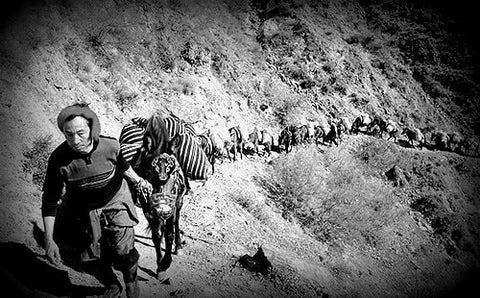
Ancient Tea Horse Road © Sichuan Provincial Tourism Bureau
In our modern tea age, puerh is created intentionally after the leaves are picked. The leaves are sun dried to remove moisture and then partially fried in a large wok. The process differentiates itself from green tea at this stage. Green tea would be dried with hot air to prevent further oxidation. Puerh is allowed to dry in the sun and thus fermentation can continue. Because of the care taken in processing, puerh is allowed to ferment and age long after it is sold at market. Like wine it can continue to age for many decades. The microorganisms cultivated in Yunnan continue to change the leaf improving the flavor with time. Puerh is alive!
Similar to wine, the Chinese government has taken additional steps to protect the name puerh and only allows leaves harvested in Yunnan to carry the name puerh. Puerh can be further broken down into two main categories; raw / green and ripe / cooked / red. Those differences I will outline in a different blog. Given that the flavor of puerh ages with time, and taking into consideration differing quality in weather and harvesting from year to year, differences in processing and storage, pinpointing a single taste to puerh is not possible. That’s a good thing! Exploring the amazing world of puerh can be a delicious adventure.
Given the probiotic nature of puerh there are numerous health benefits. I enjoy puerh for the flavor, but it doesn’t hurt that it is also beneficial to my health. Puerh drank after heavy meals can help break down the fats and aid in digestion. It is used to lower blood pressure, reduce cholesterol, aid in weight loss, and is full of antioxidants. It is also claimed to be a handy hangover remedy, although I am past the time in my life where I drink enough to experience hangovers, I don’t doubt the claim. Drink it for the flavor or for the health benefits.
If you’ve never tried puerh before and are in the Seattle area stop by for a tea tasting. [ crimsonlotustea@gmail.com ] If not try to find a ripe puerh around 5 years old and give it a try. I find that first time puerh drinkers prefer ripe puerh. Raw puerh has amazing flavor possibilities, but ripe puerh is more mellow and seems more suited to a western palate in my experience. Enjoy exploring puerh!
What is Puerh? August 27 2013
What is Puerh? Six months ago I had no idea. I’m not entirely certain how there was a blank hole in my mind where puerh should have been. In all my travels and experiences I am certain to have had puerh along the way. Perhaps no one took the time to explain what I was drinking and I didn’t remember if they told me. That all changed this year.
I spent the better part of the first half of 2013 on a 10,000+ mile long solo road trip across the southern half of America. Just me, the road, and my trusty mad max styled monster truck. It was awesome. It’s what everyone dreams about doing some day but usually never will. I used the trip as an excuse to search the country for good coffee.
Coffee is my first love. I mean real coffee, not the over-roasted, caffeinated sugar milk that Starbucks peddles. I am passionate about coffee in ways most people wouldn’t understand. I roast my own beans, I agonize over the perfect ratio of water to beans, I measure everything to the gram, and I need my water at exacting temperatures (176°). I travel with my own hand grinder, water kettle, fresh beans, and assorted coffee paraphernalia. To say I am passionate about coffee puts it lightly. Coffee is (was) my world. All that changed when I reached Santa Cruz, California.
My trip took me to Santa Cruz to visit an old college buddy. Santa Cruz is a great little town. Quirky, fun, and proud of itself. While there my friend convinced me that I needed to visit the Hidden Peak Teahouse [ http://hiddenpeakteahouse.com/ ] and experience their gongfu tea service. I was intrigued. I was not aware the term gongfu could be used outside of the martial arts. While on this road trip I learned to take the adventure wherever it led and made a point of visiting this teahouse.
I visited Hidden Peak on a quiet, sunny afternoon in May. The teahouse, as the name implies, is hidden right downtown. I sat down and the owner asked if I knew what I was doing and I confessed that I did not. I picked a puerh that I thought looked interesting and he showed me the entire process. If anything, I am a sucker for process and procedure. I love to take my time giving attention to tiny details. I enjoy the little things. I was shown how good puerh can be brewed many times and is very forgiving for temperature. I learned that each time the leaves are steeped they have new flavors to reveal.
As soon as I tasted that puerh tea my world changed. Maybe that sounds cliched but it has quite literally had that effect. The tea had such amazing flavor. It was so rich and dark and smooth and memorable. It was also incredibly familiar. I had never experienced anything quite like it, and yet I felt like I knew it. I had a very deep emotional connection with that tea. What was this drink? How had I not heard of this before? Did others know about this drink? This was the start of what has become a real passion for me.
After returning to my friends house I had a lot of questions about puerh that his roommate was able to answer. We talked at length about puerh. The next morning he treated me to some of his own puerh in a gongfu tea ceremony in his living room. It was enchanting; a memorable experience. One thing he told me took me by surprise. Puerh is a tea cultivated exclusively in Yunnan, China. My soon to be wife was from Yunnan, China.
When I asked her about puerh she was genuinely surprised at my interest in it. She said most people in Yunnan drink green tea and not puerh. I have come to conclude this is because of a sort of grass is greener effect. Puerh has been an export from Yunnan for so long that it is taken largely for granted among the people who live there.
I never really drank coffee for the caffeine. I drank coffee because I loved the flavor. Straight black, no sugar, cream, or artifical flavors was the only way. Seattle is home to some of the best coffee roasters in the world. Shops like Stumptown, Victrola, and Caffe Vita demonstrate what coffee really has to offer to a discerning palate. This was the flavor experience I sought. Each morning I would grind some beans first thing and begin the lengthy process to create a perfect cup of coffee. I would drink this magical elixir and then get started with my day. I would take an afternoon espresso if I was near a trustworthy barista, but that was about as much caffeine as I wanted in a given day. I yearned for an excuse to drink more coffee, but I just really didn’t want that caffeine. I wanted the chance to enjoy many cups of coffee, but without the caffeine (decaf doesn’t count).
Once I got back to Seattle I stopped at a tea shop in the International District and bought some puerh that to me, at the time, seemed wildly expensive. It was $100 for a 400 gram cake. He broke off roughly half and sold it to me for $45. I bought a small Yixing pot and went home to try it out. The first thing I did was fabricate a makeshift gongfu table so I could attempt to mimic the process I had been taught. That worked for about a week before I ended up having to buy a real table. I practiced brewing puerh in the gongfu style every day. I didn’t even notice that I wasn’t making myself coffee anymore. With puerh I found that I can continue to re-steep leaves all day if I wish to. I can have a delicious drinking experience as often as I wish without worrying about being overcaffeinated.
Doing some quick math it was apparent that using 5 grams of leaves from a 400 gram cake of puerh per day made even expensive cakes of puerh quite affordable in comparison to my coffee habit. If I wanted good coffee to make at home I was looking at spending ~$25/pound for fresh and fancy beans from a local roaster. A pound of coffee, brewing it how I brew it (21 grams per session), would work out to about 21 cups of coffee. That’s a little over a dollar per cup. That’s not too bad, but that’s just one cup per day. A cappuccino in the afternoon would add another $5 (with tip). Now with puerh a 400 gram cake worth $100, using 5 grams a day works out to be $1.25. The great part is that I can use those 5 grams all day long. That $100 cake is suddenly a lot better deal than drinking coffee.
I didn’t even really realize that I had stopped drinking coffee entirely until a few weeks later. I made myself some coffee the way I had thousands of times. The experience was lacking. The flavor felt primitive. I was disappointed. I then brewed some puerh and the depth of the experience and flavor was overtly obvious. Puerh is what I have been looking for all along. I don’t miss coffee.
I joked with my wife-to-be that we should use her connections in Yunnan and start a tea import business specializing in puerh and educate Westerners on what an amazing thing puerh tea is. She said “Why not?”, and I had no response. It dawned on me that we could make this work. Crimson Lotus Tea was born.
- Previous
- Page 3 of 3
